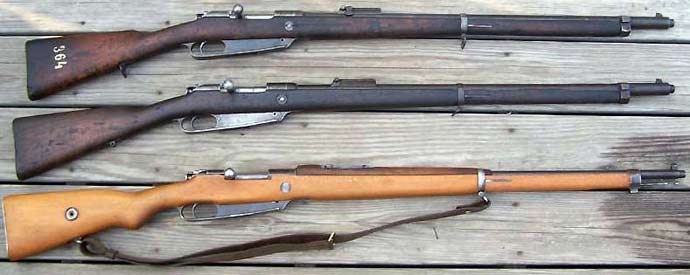Note: Not technically a Mauser however based on a Mauser action.

The Gewehr 88 (commonly called the Model 1888 Commission Rifle) was a late 19th century German bolt-action rifle, adopted in 1888.
The invention of smokeless powder in the late 19th century immediately rendered all of the large-bore black powder rifles then in use obsolete. To keep pace with the French (who had adopted smokeless powder "small bore" ammunition for their Lebel Model 1886 rifle) the Germans adopted the Gewehr 88 using its own new 7,92x57 mm cartridge, which was also designed by the German Rifle Commission. The rifle was one of many weapons in the arms race between the Germanic states and France, and with Europe in general. There was also a carbine version, the Karabiner 88. Later models were updated (Gewehr 88/05 and Gewehr 88/14) and would go on to serve in World War I to a limited degree. Unlike many of the rifles before and after, it was not developed by Mauser but the Arms Commission.
Design
The Gewehr 88 is in essence a Mannlicher design, though it is sometimes (incorrectly) called a "Model 88 Mauser." It has a receiver with a "split bridge" (i.e., the bolt passes through the receiver and locks in front of the rear bridge; a rotating bolt head; and the characteristic Mannlicher-style "packet loading" system in which cartridges are loaded into a steel carrier (a clip) which holds them in alignment over a spring. As shots are fired the clip remains in place until the last round is chambered, at which point it drops through a hole in the bottom of the rifle. This system was used in almost all Mannlicher designs and derivatives, and while it allows for speedy reloading, it also creates an entry point for dirt.
Cartridge
In 1886, fifteen years after their defeat by German forces in the Franco-Prussian War, the French Army introduced the new Lebel magazine rifle firing an (8 mm) high-velocity projectile. This made Germany’s rifle, the Mauser Model 1871, obsolete due to its large and slow 11 mm round. The practical result was that the French rifle had greater accuracy and range giving French troops a tactical advantage over the German Army. In response the German Army’s Rifle Testing Commission developed the Gewehr 88 (Commission Rifle), which was adopted for service in 1888.
German Empire, 1871–1918; Adoption of the rifle included parts of modern day Poland but not Bavaria
German Empire, 1871–1918; Adoption of the rifle included parts of modern day Poland but not Bavaria
The first step was to design a cartridge; M/88 7,92x57 mm. This began by adapting a Swiss design resulting in a new 7.92 mm rimless "necked" cartridge, which featured smokeless powder. The basic design of the cartridge would be adopted for higher technology powders, and shift to pointed 'Spitzer' bullets (though the trend was started by the French). The new round was not compatible with older rifles, and they had to be converted. This was similar to the United States change from 30-03 to 30-06. The newer round is still popular today with hunters (commonly known as the 8 mm Mauser in the USA) it remained in military service until West Germany adopted the standardized NATO ammunition after World War II. The later light pointed bullet (Spitzgeschoß) round was introduced only in 1904/05, so the early Gewehr 98 was still designed for the older round-nose bullet, and had different sights.
Bolt and barrel
The Commission Rifle's bolt action design was a modified Mannlicher action with a few Mauser features, but it is incorrect to call it a "Mauser." The barrel design and rifling were virtually copied from the French Lebel, and the magazine was based on a popular Ferdinand Mannlicher design, which allowed for rapid reloading. The rifle has an odd appearance as the entire barrel is encased in a sheet metal tube for protection, but with the tube removed the rifle looks rather modern. However within ten years a true Mauser design would be adopted, the Gewehr 98, which was the culmination of a series of Mauser models in the 1890s. It was a superior replacement using the same ammunition with a stronger powder charge. However, this rifle soon had to be converted to fire the new pointed round that Germany adapted after the turn of the century.
Service
The Commission Rifle saw field service with Germany's colonial expansion, including in China during the Boxer Rebellion, and served as a front line weapon for German troops during World War I until 1915 when there where enough Gewehr 98s ; however, it was used extensively by the Turkish Army even through World War II. Some early models had flaws due to rushed ammunition production; anti-Semitic factions within the German press exploited the flaws citing a conspiracy between the rifle’s manufacturer, the Ludwig Loewe Company, and other Jewish owned manufactures, including the firm manufacturing the smokeless powder. Thus the rifle became known derisively as the Judenflinte ("Jews' Musket"). Many Gewehr 88 rifles stayed in active service in second-line units, reserves, and in armies allied with the Germans through and well past World War I. Most of the Gewehr 88s seen in the USA are the ones given to the Turkish forces in World War I and have been modified from the original design. The Turks issued these and updated versions at least as late as the 1930s. Gewehr 88/05 rifles were also used by Yugoslavia and Czechoslovakia, mostly ones that were captured from German forces in World War II. A few are encountered with Finnish markings. The Republic of China also used this rifle extensively in the Republican era, but locally built models proved to be hopelessly defective and were quickly phased out.
The rifle was adopted during a period of rapid development in firearms technology. Although its period as the primary official service rifle was just over a dozen years, it remained in limited service for much longer. It also marked Germany's shift to a smokeless powder (but not spitzer tips), as well as providing a basis for early 1900 versions of it.
The Gewehr 88 is also known as the "Commission rifle," or "Reichsgewehr," a name derived from the fact that the design was based on the specifications of a German military commission looking for a replacement for the older Model 71 and 71/84 Mauser rifles. It was soon replaced as front line issue by the Gewehr 98 in 1898, which stayed in service with modifications until the end of World War II. The Gewehr 88 was also sometimes made into very elegant sporting rifles by custom gunmakers in Germany. Examples of these usually show first-class workmanship and special features such as folding sights, altered bolt handles and so on.
Modification
At the time of adoption, the "Patronen 7.92x57mm" was loaded with a bullet that measured 0.3188" in diameter. In 1897, the German Army changed the specifications of the cartridge to use a bullet 0.321" in diameter and Gewehr 88 rifles made from that date on had .323" diameter bores. Any rifle rebarreled after that date received a .323" diameter barrel. However, this is a misleading statement, as the tolerance on the barrels ranged from .318" to .325" (8.07mm to 8.25mm). The more important change was a wider chamber throat to take the thicker brass of the new cartridge. Rifles with this change have the receiver marked with a large "S". Gewehr 88/05 rifles were converted to use the Gewehr 98 type stripper clip by adding stripper clip guides to the top rear of the receiver and altering the magazine. The powder load used for the Gewehr 88 is also less than that of any other 8 mm Mauser rifle, as the makers of the Gewehr 88 did not understand the great power of smokeless powder compared to black powder. Shooters planning to use modern 8 mm Mauser ammunition should slug their bore as there are four different bore and groove combinations found on the Gewehr 88 rifle. Ammunition designated for machine guns should never be fired in a Commission Rifle.
Defects
Although the packet loading system proved to be a design defect, it is not uncommon to encounter a Gewehr 88 today which still retains it. Some of them were modified to use the stripper clips used with the Gewehr 98 by milling a slot into the left side of the action and adding stripper clip guides on the top of the receiver. Through this slot projects a bar which retains the cartridges in place against the magazine spring's pressure. The hole in the bottom of the rifle is often covered with a small piece of sheet metal.
Unlike many rifles designed later, the bolt head of this rifle is able to be removed from the bolt body. This piece could be removed during disassembly, and was frequently lost. Additionally, both the ejector and the extractor that are attached to the bolt head are prone to falling out if care is not taken during disassembly and reassembly.





